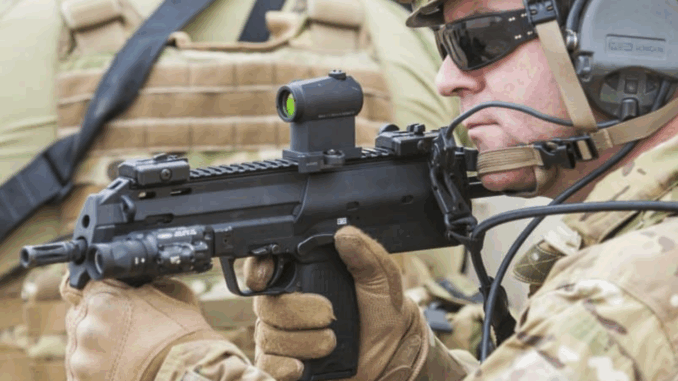
In an era of constant weapons development, most firearms come and go—but a few staples remain among elite units for one reason: they solve a specific problem better than anything else.
For DEVGRU, the Navy’s Tier 1 Special Mission Unit, the Heckler & Koch MP7 is one such weapon.
Lightweight, compact, and capable of defeating soft body armor, the MP7 continues to occupy a trusted role in DEVGRU’s armory. It isn’t a general-purpose rifle, and it’s not just a modern subgun. It fills a narrow but vital niche—and it does compare with purpose-built precision.
The PDW Concept That Found Its Way to Tier 1
The MP7 was born from a 1990s NATO requirement calling for a compact shoulder-fired weapon that could outperform a pistol but remains smaller than a carbine. While the program never matured, it produced two landmark designs: FN’s P90 and HK’s MP7.
HK’s submission stood apart for its use of a proprietary 4.6x30mm round—a cartridge engineered specifically to pierce modern soft body armor while remaining controllable in a lightweight platform. DEVGRU adopted the MP7 in limited roles where those characteristics are critical.
While the U.S. military tends to standardize around 5.56mm platforms, DEVGRU isn’t a conventional force.
It has the latitude field to specialized weapons when mission profiles demand it. That flexibility is what keeps the MP7 in their kit to this day.
Designed for a Specific Mission Profile
The MP7 came out of a 1990s NATO effort to arm support troops with something more capable than a handgun, but smaller than a rifle.
While that PDW initiative never took off on a large scale, two standout designs emerged from it: the FN P90 and the HK MP7. DEVGRU chose the latter—and for good reason.
The MP7 is lightweight, highly maneuverable, and designed for use in confined environments. With the stock collapsed, it measures just over 16 inches.
Fully extended, it’s still under 26 inches. At roughly 4.6 pounds unloaded, the MP7 can be easily slung, stowed, or even fired one-handed when circumstances demand it.

The 4.6x30mm Cartridge: Small but Effective
Designed alongside the platform itself, the 4.6x30mm round bridges the gap between pistol and rifle performance. It uses a bottlenecked case and spitzer-style projectile to produce high velocity in a short barrel.
While it lacks the terminal ballistics of 5.56 NATO, it compensates with a flat trajectory and proven armor-piercing capability out to 150–200 meters.
Multiple loadings exist—standard FMJ, AP Combat Steel, frangible, subsonic, and even hollow points—allowing customized performance depending on the mission.
The subsonic variant is particularly useful for suppressing entry work, especially in CQB where flash and sound signature must be minimized.
Not a Rifle—Not a Pistol
Make no mistake: the MP7 does not replace a 5.56mm carbine in terms of long-range performance or terminal ballistics. But for those missions where a primary long gun isn’t practical—or when extreme mobility is a higher priority than reach—the MP7 fills the gap.
It’s not unusual to see the MP7 deployed as a secondary weapon, particularly for breachers, snipers, or others whose hands are tied up with heavy or specialized gear. The combination of low weight, low recoil, and body armor penetration keeps it relevant even decades after its initial adoption.
Why You Can’t Buy One
As expected, the full-auto MP7 is classified as a machine gun under the National Firearms Act (NFA) and is not available to civilians due to the 1986 Hughes Amendment.
Semi-auto versions like the HK 97 exist in other markets, but HK has not made them available for U.S. civilian sales.
A few clones exist, but they’re expensive, rare, and often lacking in performance.
Final Word
The MP7 wasn’t designed to be a general-purpose rifle—and it doesn’t try to be. It exists for a narrow but critical range of use cases where its size, control, and ballistic profile offer a clear tactical advantage.
That’s why DEVGRU still carries it. When the mission calls for mobility, speed, and a low-profile weapon capable of defeating armor, the MP7 delivers—without compromise.
